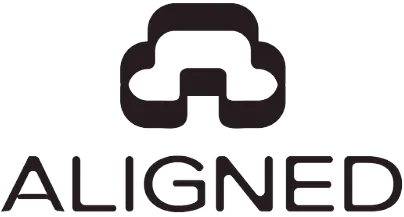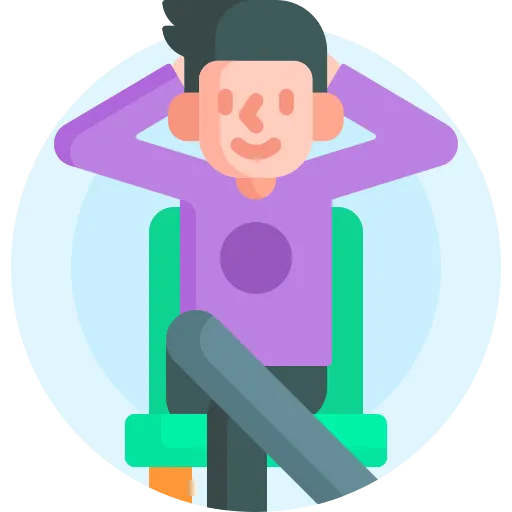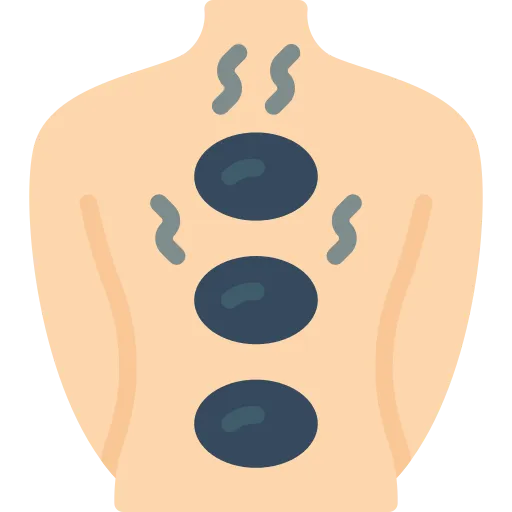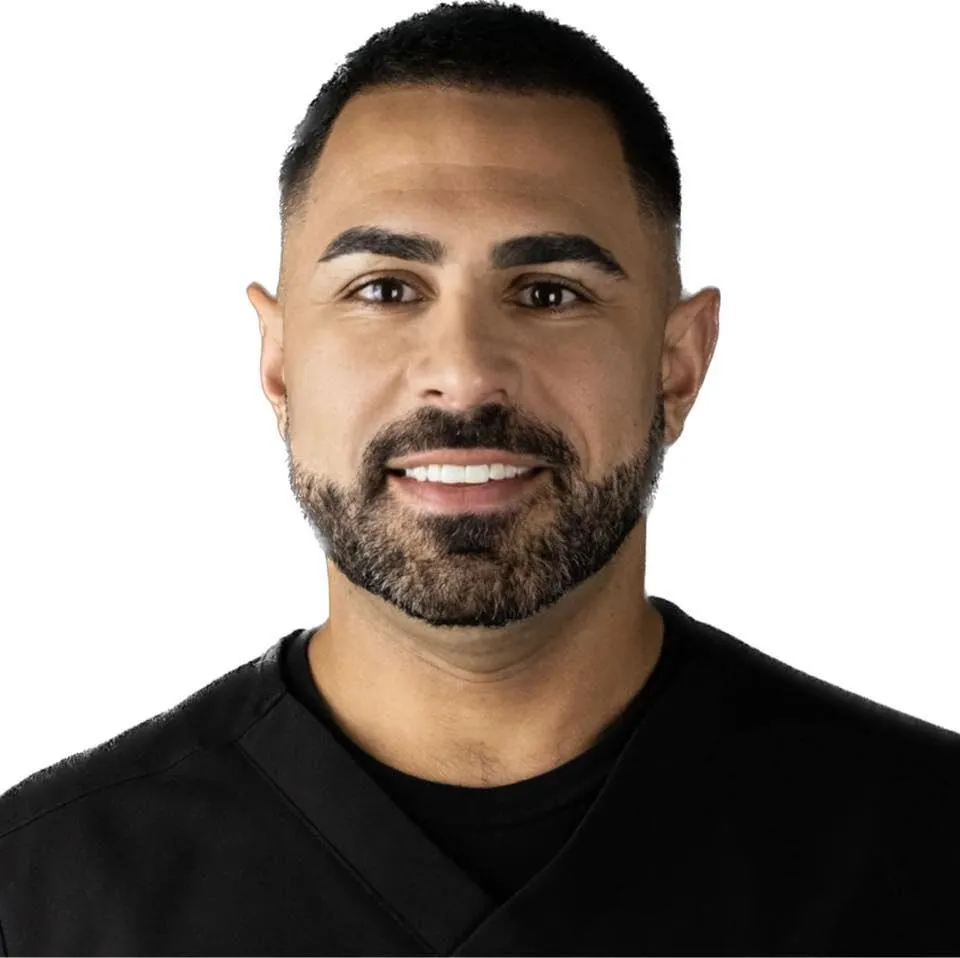
Get Back to Living Pain-Free!
$37 New Patient Special


Effective, Non-Surgical Relief
The Back on Trac provides a safe, surgery-free option for back pain, sciatica, and disc issues, offering effective relief without downtime.

Comfort-First Experience
Unlike traditional decompression machines, the Back on Trac uses a reclining, seated position, giving patients a comfortable, relaxing experience.

Tailored Pain Relief
With adjustable settings that target specific spinal areas, patients receive personalized treatment that promotes lasting results.

Dr. Travis Fahey, DC
Chiropractor/Founder at Aligned Chiropractic
Travis Fahey, DC is an Iraq War veteran whose mission is to help others live healthier, more fulfilled lives.
He has been helping patients in the Dallas area feel their best for over 10 years.
With advanced training in spinal decompression therapy and spinal correction, Dr. Fahey specializes in treating chronic back pain naturally.
At Aligned Chiropractic, we're committed to providing personalized care that fits your lifestyle.
200+ 5 Star Reviews

Dr. Fahey and his sweet team are so amazing! I came in with extreme back pain and after my treatment, I’m finally able to sleep and move around so much better. It’s been such a blessing. Can’t recommend them enough!!
ELYSE TORRES
July, 2024

Dr. Fahey changed my life! I was in debilitating pain, all I thought about was the pain, I couldn’t focus and he helped me through a therapy plan that I needed to commit to and by doing so I’ve improved so much. I can work and focus on normal things in my life again.
ANUM ALI
July, 2024

Got into a car accident , was referred to this amazing chiropractor , since my first session i felt immediate relieve , i was able to get my bbl after done with my treatment since i no longer had any back issues.
NANI GARCIAAA
April 1, 2021

Dr. Fahey and his team is the bomb! I’m not the type of person that hands out compliments, readily and yet here I am extending this compliment! The treatments have benefited me in my Bikram Yoga practice, re-engaged my core front/back muscles and has greatly assisted my posture.
JOSHLYN HENDERSON
July, 2024

The price is affordable customer service is excellent I have been to multiple doctors trying to figure out what's the best service for my scoliosis and this has been the best chiropractor I found my first week has been the best I felt in a long time.
TAMMY VALENTINE
July, 2024

Just finished my first consultation and treatment with Dr Fahey and I’m very pleased with how intently he listened to my issues and explained the treatment plan. After years of back pain, I have some hope in relieving it, finally.
KRISTINA BOWMAN
February, 2024

After dealing with lower back pain for 10 years after my 1st visit I could feel the relief in my lower back! Amazing service from the entire staff!
ROD A-BASSIN
August, 2024

I am positive this place is working miracles. I have felt great improvements in my quality of rest and reduction in pain. Everyone in the office is also very nice and I enjoy each visit.
STACI BARRIOS
January, 2024

Location
Dallas, TX 75231 (1.5 mi from North Park Mall)
Start Your Journey To Pain-Free Living!
Claim your you spot below for $37
(Includes Consultation, X-rays and Spinal Decompression Therapy)
Only a few spots remaining
Special ends 11/22/24
Frequently Asked Questions
What is spinal decompression therapy?
Spinal decompression therapy is a non-surgical treatment aimed at relieving back pain and other related symptoms. It involves gently stretching the spine to change its force and position. This change takes pressure off the spinal discs, which are gel-like cushions between the bones in your spine. By doing so, it can help retract bulging or herniated discs, relieving pressure on nerves and other structures in your spine.
How does spinal decompression work?
Mechanical Traction: A spinal decompression machine applies gentle, controlled force to the spine. Patients typically lie on a special table, and a harness is placed around their pelvis and trunk. The machine then alternates between stretching and relaxation phases, which creates a negative pressure within the spinal discs.
Pressure Relief: This negative pressure can help herniated or bulging discs retract, reducing the pressure on nerves and other structures in the spine. It also promotes the movement of water, oxygen, and nutrient-rich fluids into the discs, which helps them heal.
What conditions can spinal decompression treat?
Herniated or Bulging Discs: Decompression can help reposition the discs, reducing pressure on nerves.
Degenerative Disc Disease: It can alleviate pain by increasing disc height and improving spinal alignment.
Sciatica: By relieving pressure on the sciatic nerve, decompression can reduce symptoms of sciatica.
Is spinal decompression therapy safe?
Spinal decompression therapy is a safe and effective treatment option for many individuals with back pain, herniated discs, sciatica, and related conditions. However, it is important to consult with a healthcare professional to determine if it is suitable for your specific situation and to ensure that it is performed safely and effectively.
Who is a good candidate for spinal decompression?
A good candidate for spinal decompression therapy is someone who suffers from certain types of back pain or spinal conditions and has been evaluated by a healthcare professional. Here are some common characteristics of individuals who may benefit from spinal decompression therapy:
Conditions Treated
1. Herniated or Bulging Discs: Patients with discs that have protruded or slipped out of their normal position can benefit from spinal decompression, as it helps retract the discs and relieve pressure on the nerves.
2. Degenerative Disc Disease: Individuals with age-related disc wear that causes pain and discomfort can find relief through spinal decompression by improving disc health and spacing.
3. Sciatica: Those experiencing pain, tingling, or numbness along the sciatic nerve due to spinal disc pressure can benefit from decompression therapy.
4. Spinal Stenosis: Patients with narrowing of the spinal canal that causes nerve compression may experience relief with spinal decompression.
5. Facet Syndrome: Individuals with inflammation or degeneration of the facet joints in the spine can benefit from decompression therapy as it alleviates pressure on these joints.
Patient Characteristics
• Chronic Back Pain: Those with persistent back pain that has not responded well to other conservative treatments, such as physical therapy, medications, or chiropractic care.
• Desire to Avoid Surgery: Individuals looking for a non-surgical alternative to relieve back pain and improve function.
• Ability to Commit to Treatment: Patients who can commit to a series of treatment sessions over several weeks, as spinal decompression typically requires multiple visits for optimal results.
Exclusion Criteria
Spinal decompression therapy may not be suitable for everyone. Individuals with the following conditions are generally not considered good candidates:
• Pregnancy: Due to potential risks to the fetus.
• Advanced Osteoporosis: Weakened bones may not withstand the mechanical forces of decompression.
• Spinal Fractures: Acute fractures can be exacerbated by decompression.
• Spinal Tumors: Decompression is not advisable for those with spinal tumors.
• Metal Implants in the Spine: Implants may interfere with treatment.
• Severe Nerve Damage: Decompression may not be effective for those with significant nerve impairment.
Consultation
It is important for patients to consult with a qualified healthcare provider to determine if spinal decompression therapy is appropriate for their specific condition. This evaluation will typically involve a comprehensive assessment, including a medical history review, physical examination, and imaging studies, to ensure the treatment is both safe and potentially effective.
How many sessions are typically needed?
Research shows that 20-24 visits is the ideal amount of treatments needed.
What does spinal decompression feel like?
Spinal decompression therapy is generally a comfortable and relaxing experience for most patients. Here's what you can typically expect during a session:
During the Session
Setup:
• You will lie on a special table designed for spinal decompression.
• A harness is placed around your legs at your calves and under your arms to secure you in place.
• The table is then adjusted to target the specific area of the spine that needs decompression.
Gentle Stretching:
• The table slowly moves to gently stretch the spine, creating negative pressure within the spinal discs.
• You might feel a pulling or stretching sensation in your back or neck as the table moves.
• This process is typically painless, and many patients find it relaxing.
Alternating Phases:
• The session usually involves a series of alternating phases of stretching and relaxation.
• Each stretch phase lasts for about 45 to 60 seconds, followed by a relaxation phase.
Duration:
• A typical session lasts about 5 to 10 minutes.
• Patients may listen to music or engage in relaxation techniques during the session.
Sensations During and After
• Comfort: Most patients report feeling a gentle, soothing stretch, and some may even fall asleep during the session.
• Relief: Many experience a sense of relief as pressure is alleviated from compressed discs and nerves.
• Mild Soreness: Some patients may feel mild soreness or muscle spasms afterward, similar to what you might experience after a workout. This is usually temporary and can be managed with rest, ice, or over-the-counter pain relievers.
After the Session
• Relaxation: Patients often feel relaxed and may notice an immediate reduction in pain.
• Gradual Improvement: While some may experience immediate relief, others may notice gradual improvement over the course of several sessions.
Patient Comfort
• Communication: It’s important to communicate with the practitioner throughout the session. If you feel any discomfort, they can adjust the settings to ensure you remain comfortable.
• Individual Experience: The sensations experienced can vary from person to person, depending on individual conditions and pain thresholds.
Overall, spinal decompression therapy is designed to be a gentle, non-invasive treatment that can provide significant relief from back pain and associated symptoms for many patients.
Are there any side effects of spinal decompression?
Spinal decompression therapy is generally considered safe, but like any treatment, it can have some side effects. Most side effects are mild and temporary, but it's important to be aware of them and to communicate with your healthcare provider if you experience any discomfort. Here are some potential side effects of spinal
decompression therapy:
Common Side Effects
1. Muscle Soreness:
• Some patients may experience mild muscle soreness or stiffness, similar to what you might feel after exercising. This usually resolves within a day or two.
2. Muscle Spasms:
• In some cases, the muscles around the treated area might spasm in response to the stretching, but this is typically temporary.
3. Increased Pain:
• A small number of patients might experience an increase in pain immediately following treatment. This is often temporary and can be managed with rest, ice, or over-the-counter pain relievers.
4. Headache:
• Occasionally, patients might experience a headache after treatment, especially if the neck area is being treated. This is typically short-lived.
5. Tingling or Numbness:
•Some individuals may feel tingling or numbness in the treated area, but this sensation usually subsides quickly.
Minimizing Side Effects
• Qualified Practitioner: Ensure that spinal decompression therapy is administered by a trained and experienced healthcare professional.
• Proper Evaluation: A thorough evaluation should be conducted to determine if you are a suitable candidate for the therapy.
• Communication: Communicate openly with your provider about any discomfort or concerns during the session so they can adjust the treatment as needed.
• Follow-up Care: Adhere to any recommended post-treatment care, such as exercises or lifestyle adjustments, to enhance the effectiveness of the therapy and minimize side effects.
Who Should Avoid Spinal Decompression
Spinal decompression therapy may not be appropriate for individuals with certain conditions, such as:
• Advanced osteoporosis
• Spinal fractures
• Spinal tumors
• Abdominal aortic aneurysm
• Metal implants in the spine
• Severe nerve damage
• Pregnancy
If you have any concerns about the side effects of spinal decompression therapy, it's important to discuss them with your healthcare provider. They can provide personalized advice and help determine the best treatment approach for your specific condition.
What is the success rate of spinal decompression?
The success rate of spinal decompression therapy can vary based on several factors, including the specific condition being treated, the severity of the condition, the individual patient, and the treatment protocol used. While there isn't a universally agreed-upon success rate, many studies and clinical reports suggest that spinal decompression can be effective for a significant number of patients.
Reported Success Rates
1. General Success Rates: Clinical studies and patient surveys often report success rates ranging from 70% to 90% for relieving pain and improving function in patients with conditions such as herniated discs, degenerative disc disease, and sciatica.
Condition-Specific Outcomes:
• Herniatesoni baad Discs: Patients with herniated discs often experience significant pain relief and improved mobility. Some studies report success rates of 75% or higher.
• Degenerative Disc Disease: Success rates can vary, but many patients report reduced pain and improved quality of life.
• Spinal decompression can be particularly effective for relieving sciatica symptoms, with some reports indicating success rates around 80%.
2. Patient Satisfaction: Many patients report high levels of satisfaction with spinal decompression therapy, particularly those who have not found relief with other conservative treatments.
Factors Influencing Success
1. Patient Selection: The success of spinal decompression is often higher in carefully selected patients who are good candidates for the therapy.
2. Severity and Duration of Condition: Patients with less severe conditions and those who have not had symptoms for an extended period may experience better outcomes.
3. Adherence to Treatment Protocol: Completing the recommended number of sessions and following any prescribed post-treatment care can significantly impact success rates.
4. Complementary Therapies: Combining spinal decompression with other treatments, such as physical therapy or chiropractic care, can enhance outcomes.
Can spinal decompression help with lower back pain?
Yes, spinal decompression therapy can be an effective treatment for lower back pain, particularly when the pain is associated with specific spinal conditions. It is designed to relieve pressure on the spinal discs and nerves, which can significantly reduce pain and improve mobility.
What should I do to prepare for a spinal decompression session?
Recommendations on pre-treatment preparations or considerations.
Will my insurance cover spinal decompression therapy?
Spinal decompression is not a covered service under medical insurance. However, we can give you a detailed bill for reimbursement on eligible services.
Can I continue other treatments while undergoing spinal decompression?
Yes, you can often continue other treatments while undergoing spinal decompression therapy, and sometimes combining treatments can enhance overall outcomes. However, it's important to coordinate these treatments with your healthcare provider to ensure they complement each other effectively.
Telephone
972-213-8559
Location
10455 N. Central Expressway, Suite 101
Dallas, TX 75231
Copyrights 2023 | Dr. Travis Fahey | Terms & Conditions | Privacy Policy